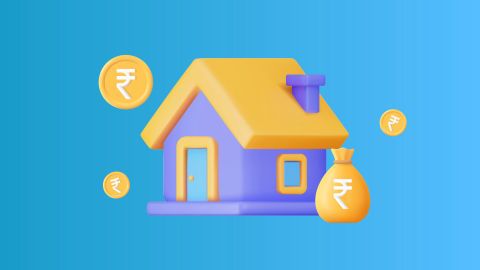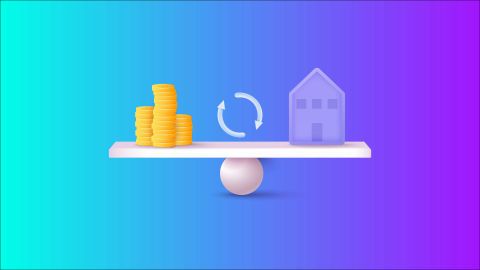When you begin earning, one of the first things you learn is the importance of saving money. A major way to do this is by reducing the amount of tax you pay each year. If your annual salary is Rs. 12 lakh or more, you may often worry about how much of it goes in taxes. The good news is that it is not as complicated as it seems. With a basic understanding of the tax rules, along with some careful financial planning, you can manage your liability better by using exemptions and deductions effectively.
Income tax slabs under the new tax regime for FY 2025-26 (AY 2026-27)
In the 2025 Budget, the government introduced updated income tax slabs under the new tax regime. The revised structure increases slab ranges to Rs. 4 lakh intervals, and a 25% tax rate was added. These changes aim to simplify taxation while maintaining clarity across different income brackets for FY 2025–26 (AY 2026–27).
Annual income |
Income tax rate |
Up to Rs. 2.5 lakh |
Nil |
Rs. 2.5 lakh – Rs. 4 lakh |
Nil |
Rs. 4 lakh – Rs. 5 lakh |
5% |
Rs. 5 lakh – Rs. 8 lakh |
5% |
Rs. 8 lakh – Rs. 10 lakh |
10% |
Rs. 10 lakh – Rs. 12 lakh |
10% |
Rs. 12 lakh – Rs. 16 lakh |
15% |
Rs. 16 lakh - Rs. 20 lakh |
20% |
Rs. 20 lakh - Rs. 24 lakh |
25% |
More than Rs. 24 lakh |
30% |
Comparison of old vs. new income tax slabs as per Union Budget 2025
Before looking into tax-saving strategies for a salary above Rs. 12 lakh, it is necessary to know which tax slab applies to you. In India, income tax is calculated differently depending on whether you opt for the old or the new regime. The old regime allows various exemptions and deductions, giving taxpayers flexibility but requiring detailed planning. In contrast, the new regime has lower and simpler rates, though fewer deductions can be claimed. Choosing the right regime depends on your income structure and how much you usually claim through exemptions and deductions in a financial year.
Income tax slabs: Old vs. new regime for FY 2024-25 (AY 2025-26)
Income slab (Rs.) |
Old regime tax rate |
New regime tax rate (2025) |
Up to Rs.2.5 lakh |
Nil |
Nil |
Rs.2.5 lakh – Rs.4 lakh |
5% |
Nil |
Rs.4 lakh – Rs.8 lakh |
5% |
5% |
Rs.8 lakh – Rs.12 lakh |
20% |
10% |
Rs.2 lakh – Rs.16 lakh |
30% |
15% |
Rs.16 lakh – Rs.20 lakh |
30% |
20% |
Rs.20 lakh – Rs.24 lakh |
30% |
25% |
Above Rs.24 lakh |
30% |
30% |
Key changes in Budget 2025
The Budget 2025 brought several taxpayer-friendly updates. Firstly, no tax is payable on incomes up to Rs. 12 lakh, thanks to an enhanced rebate under Section 87A. Secondly, tax rates have been reduced for incomes between Rs. 12 lakh and Rs. 24 lakh. Thirdly, while the old regime remains unchanged, it still allows deductions such as 80C and HRA. Note that the new regime restricts many of these traditional exemptions.
Tax saving options under new and old tax regime
Below is a comparative overview of tax-saving opportunities available under the old and new tax regimes:
New tax regime – Allowed deductions
Although limited, certain deductions are still available under the new system:
Deduction type |
Details |
Standard deduction |
Rs. 75,000 |
Employer’s NPS contribution |
Allowed under Section 80CCD(2) |
Agniveer Corpus Fund |
Deduction under Section 80CCH |
Family pension |
Deduction as per Section 57(iia) |
Conveyance and transport allowance |
Applicable, especially for specially-abled individuals |
Gratuity and leave encashment |
Exempt under Sections 10(10), 10(10AA), 10(10C) |
Interest on home loan (Let-out Property) |
Deduction allowed under Section 24 |
Old tax regime – Exemptions and deductions
The old regime offers a wider variety of tax-saving tools, grouped into two categories:
Part A: Benefits under 'Salary'
Component |
Tax treatment |
Basic and DA |
Fully taxable |
HRA |
Partially exempt (subject to limits) |
LTA |
Exempt twice in a four-year block |
Internet/Mobile reimbursement |
Exempt with valid bills |
Children's education allowance |
Rs. 4,800 annually (up to 2 children) |
Food coupons |
Up to Rs. 26,400 yearly |
Professional tax |
Usually Rs. 2,400 |
Standard deduction |
Rs. 50,000 |
Part B: Deductions under Chapter VI-A
Section |
Deduction |
80C |
Up to Rs. 1.5 lakh (EPF, PPF, ELSS, SSY, NSC, etc.) |
80D |
Rs. 25,000–50,000 (health insurance) |
80E |
Interest on education loans (up to 8 years) |
80G |
Donations to approved charities (50% or 100%) |
80DD |
Rs. 75,000–1.25 lakh (for disabled dependents) |
Section 24(b) |
Up to Rs. 2 lakh (home loan interest) |
Example on calculation of tax under new and old tax regime
Old regime
Particulars |
Amount (Rs.) |
Gross Income |
12,00,000 |
Less: HRA Exemption |
(1,20,000) |
Less: Standard Deduction |
(50,000) |
Less: Section 80C |
(1,50,000) |
Less: Section 80D |
(30,000) |
Taxable Income |
8,50,000 |
Tax Liability (incl. cess) |
85,800 |
Under the old regime, your taxable income reduces significantly because of deductions and exemptions. After accounting for all eligible benefits, the tax liability comes to Rs. 85,800. This system is suitable for those who actively invest in eligible instruments or have expenses like health insurance and HRA.
New Regime
Particulars |
Amount (Rs.) |
Gross Income |
12,00,000 |
Less: Exemptions |
Not applicable |
Less: Standard Deduction |
(75,000) |
Taxable Income |
11,25,000 |
Tax Liability (incl. cess) |
71,500 |
In the new regime, exemptions such as HRA or Section 80C investments cannot be claimed. However, a higher standard deduction of Rs. 75,000 is available. This results in a taxable income of Rs. 11,25,000, and the total tax payable works out to Rs. 71,500. For salaried individuals who do not wish to plan investments for deductions, the new regime often proves more convenient.
Rs. 12 lakh income tax calculation in old and new tax regime
Let’s understand how taxes are calculated for a gross salary of Rs. 12 lakh in FY 2025–26 under both tax regimes. Suppose Mr A receives an HRA exemption of Rs. 60,000, LTA exemption of Rs. 20,000, and pays Rs. 2,400 as professional tax. He also invests Rs. 1.5 lakh in PPF, pays Rs. 50,000 for his senior citizen parents’ health insurance, and pays Rs. 25,000 towards education loan interest.
Particulars |
Old tax regime |
New tax regime |
Gross Salary |
Rs. 12,00,000 |
Rs. 12,00,000 |
HRA Exemption |
Rs. 60,000 |
NA |
LTA Exemption |
Rs. 20,000 |
NA |
Standard Deduction |
Rs. 50,000 |
Rs. 75,000 |
Professional Tax |
Rs. 2,400 |
NA |
Income after Deductions |
Rs. 10,67,600 |
Rs. 11,25,000 |
Section 80C Deduction |
Rs. 1,50,000 |
NA |
Section 80D Deduction |
Rs. 50,000 |
NA |
Section 80E Deduction |
Rs. 25,000 |
NA |
Net Taxable Income |
Rs. 8,42,600 |
Rs. 11,25,000 |
Tax Before Rebate |
Rs. 84,261 |
Rs. 52,500 |
Rebate under 87A |
NA |
Rs. 52,500 |
Final Tax Payable |
Rs. 84,261 |
Rs. 0 |
Conclusion: Choosing the new tax regime in this case results in zero tax liability, saving Rs. 84,261.
Tax computation for FY 2024-25 under the old and new tax regime
Here’s a similar calculation using income figures for the previous financial year (FY 2024–25), keeping exemptions and deductions the same as in the previous example.
Particulars |
Old tax regime |
New tax regime |
Gross Salary |
Rs. 12,00,000 |
Rs. 12,00,000 |
HRA Exemption |
Rs. 60,000 |
NA |
LTA Exemption |
Rs. 20,000 |
NA |
Standard Deduction |
Rs. 50,000 |
Rs. 75,000 |
Professional Tax |
Rs. 2,400 |
NA |
Income after Deductions |
Rs. 10,67,600 |
Rs. 11,25,000 |
Section 80C Deduction |
Rs. 1,50,000 |
NA |
Section 80D Deduction |
Rs. 50,000 |
NA |
Section 80E Deduction |
Rs. 25,000 |
NA |
Net Taxable Income |
Rs. 8,42,600 |
Rs. 11,25,000 |
Tax Before Rebate |
Rs. 84,261 |
Rs. 71,500 |
Rebate under 87A |
NA |
NA |
Final Tax Payable |
Rs. 84,261 |
Rs. 71,500 |
Conclusion: In this case, the new tax regime still results in a lower tax payable, even without any deductions.
Income tax slabs for FY 2023-24 (old tax regime)
Income range (Rs.) |
Tax rate |
Up to Rs. 2.5 lakh |
Nil |
Rs. 2,50,001 - Rs. 5,00,000 |
5% |
Rs. 5,00,001 - Rs. 10,00,000 |
20% |
Rs. 10,00,001 and above |
30% |
For individuals earning Rs. 12 lakh or more, the old tax regime may still be beneficial due to higher deduction options.
Deductions and exemptions under the new tax regime
Unlike the old regime, the new tax regime has limited deductions. Below are the key tax-saving options available under the new tax regime:
- Standard Deduction: A flat deduction of ₹50,000 for salaried and pensioned individuals under Standard deduction.
- Deductions under Section 80CCD (2): Employer’s contribution to National Pension Scheme (NPS) can be claimed under Section 80CCD (2).
- No Exemptions for Allowances: Perks like House Rent Allowance (HRA), Leave Travel Allowance (LTA), and deductions under Section 80C (like PF contributions, life insurance, etc.) are not available.
- No exemptions for transport and medical allowances: Unlike the old regime, these deductions are removed.






